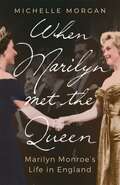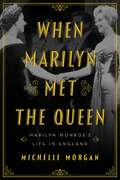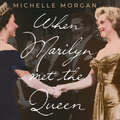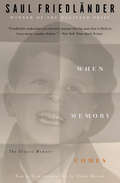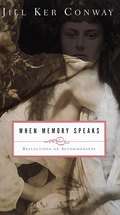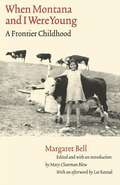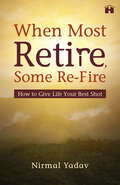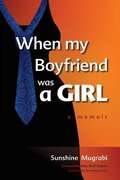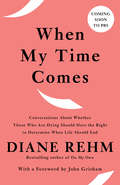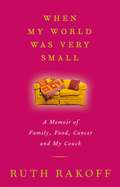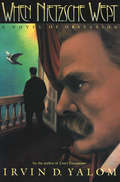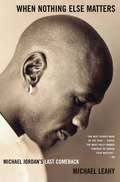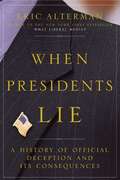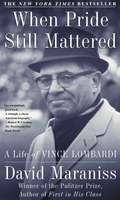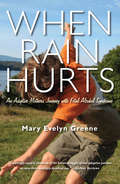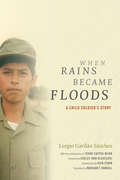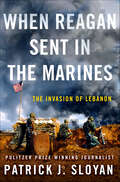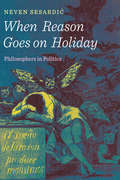- Table View
- List View
When Marilyn Met the Queen: Marilyn Monroe's Life in England
by Michelle Morgan'England? It seemed to be raining the whole time . . . Or maybe it was me'MARILYN MONROEIn July 1956, Marilyn Monroe arrived in London, on honeymoon with her husband Arthur Miller, to make The Sleeping Prince (later released as The Prince and the Showgirl) with Laurence Olivier. When the couple arrived at London Airport, they were looking forward to a peaceful stay. Marilyn would work during the day at Pinewood Studios, while Arthur would write. Then, in the evening, the couple would be able to relax together in their private English country cottage. It didn't quite turn out that way.The 'cottage' was actually a mansion, which belonged to Lord Drogheda, the managing director of the Financial Times. Raised in tiny hotel rooms and apartments, Marilyn felt herself being watched. She was, by Lord Drogheda's servants, who were selling stories to the papers. When filming began, it was a disaster. Director Joshua Logan had written to Olivier, offering advice on how to handle Marilyn as an actress, but Olivier ignored him. Instead, he condescended to her in his introduction to the cast, pooh-poohed her views on acting, and dismissed her stage-fright as an inconvenience. Marilyn grew to hate Olivier with a passion; the feeling was mutual.Marilyn found herself torn between settling into married life, being a curiosity for the frequently hostile British press, and her work on The Prince and the Showgirl. She took solace in small acts of kindness from members of the public, and a new fascination with Queen Elizabeth.Marilyn made a point of adopting some of the Queen's favourite brands, buying gloves from Cornelia James, perfume from Floris, and switching from Chanel No. 5 to Yardley's Lavender. Marilyn made a point of asking the film's PR manager to add a royal meeting to her schedule, but each day Olivier would delete the request. Michelle Morgan describes Marilyn's trip to late-1950s' Britain in evocative detail, exploring the making of the film alongside the film star's troubled private life and her quest to meet the Queen.
When Marilyn Met the Queen: Marilyn Monroe's Life in England
by Michelle MorganIn July 1956, Marilyn Monroe arrived in London—on honeymoon with her husband Arthur Miller—to make The Prince and the Showgirl with Sir Laurence Olivier. It was meant to be a happy time . . ."I am dying to walk bare-headed in the rain. I think England sounds adorable.&”—Marilyn Monroe Marilyn would work during the day at Pinewood Studios, in Iver Heath, while Arthur would write. Then, in the evening, the couple would be able to relax together in their private English country cottage. But the cottage was a mansion, in Englefield Green, and Marilyn, used to living in tiny hotel rooms and apartments, felt herself being watched. She was, by several of owner Lord Drogheda's servants, who were selling stories to the papers. And when filming began, all did not go as hoped. Over time, Marilyn grew to hate Olivier; the feeling was mutual. Marilyn found herself a curiosity for the frequently hostile British press. She took solace in bike rides in Windsor Great Park, in small acts of kindness from members of the public, and in a growing fascination with Queen Elizabeth, whom she longed to meet—and eventually did.
When Marilyn Met the Queen: Marilyn Monroe's Life in England
by Michelle Morgan'England? It seemed to be raining the whole time . . . Or maybe it was me'MARILYN MONROEIn July 1956, Marilyn Monroe arrived in London, on honeymoon with her husband Arthur Miller, to make The Sleeping Prince (later released as The Prince and the Showgirl) with Laurence Olivier. When the couple arrived at London Airport, they were looking forward to a peaceful stay. Marilyn would work during the day at Pinewood Studios, while Arthur would write. Then, in the evening, the couple would be able to relax together in their private English country cottage. It didn't quite turn out that way.The 'cottage' was actually a mansion, which belonged to Lord Drogheda, the managing director of the Financial Times. Raised in tiny hotel rooms and apartments, Marilyn felt herself being watched. She was, by Lord Drogheda's servants, who were selling stories to the papers. When filming began, it was a disaster. Director Joshua Logan had written to Olivier, offering advice on how to handle Marilyn as an actress, but Olivier ignored him. Instead, he condescended to her in his introduction to the cast, pooh-poohed her views on acting, and dismissed her stage-fright as an inconvenience. Marilyn grew to hate Olivier with a passion; the feeling was mutual.Marilyn found herself torn between settling into married life, being a curiosity for the frequently hostile British press, and her work on The Prince and the Showgirl. She took solace in small acts of kindness from members of the public, and a new fascination with Queen Elizabeth.Marilyn made a point of adopting some of the Queen's favourite brands, buying gloves from Cornelia James, perfume from Floris, and switching from Chanel No. 5 to Yardley's Lavender. Marilyn made a point of asking the film's PR manager to add a royal meeting to her schedule, but each day Olivier would delete the request. Michelle Morgan describes Marilyn's trip to late-1950s' Britain in evocative detail, exploring the making of the film alongside the film star's troubled private life and her quest to meet the Queen.
When Marilyn Met the Queen: Marilyn Monroe's Life in England
by Michelle Morgan'England? It seemed to be raining the whole time . . . Or maybe it was me'MARILYN MONROEIn July 1956, Marilyn Monroe arrived in London, on honeymoon with her husband Arthur Miller, to make The Sleeping Prince (later released as The Prince and the Showgirl) with Laurence Olivier. When the couple arrived at London Airport, they were looking forward to a peaceful stay. Marilyn would work during the day at Pinewood Studios, while Arthur would write. Then, in the evening, the couple would be able to relax together in their private English country cottage. It didn't quite turn out that way.The 'cottage' was actually a mansion, which belonged to Lord Drogheda, the managing director of the Financial Times. Raised in tiny hotel rooms and apartments, Marilyn felt herself being watched. She was, by Lord Drogheda's servants, who were selling stories to the papers. When filming began, it was a disaster. Director Joshua Logan had written to Olivier, offering advice on how to handle Marilyn as an actress, but Olivier ignored him. Instead, he condescended to her in his introduction to the cast, pooh-poohed her views on acting, and dismissed her stage-fright as an inconvenience. Marilyn grew to hate Olivier with a passion; the feeling was mutual.Marilyn found herself torn between settling into married life, being a curiosity for the frequently hostile British press, and her work on The Prince and the Showgirl. She took solace in small acts of kindness from members of the public, and a new fascination with Queen Elizabeth.Marilyn made a point of adopting some of the Queen's favourite brands, buying gloves from Cornelia James, perfume from Floris, and switching from Chanel No. 5 to Yardley's Lavender. Marilyn made a point of asking the film's PR manager to add a royal meeting to her schedule, but each day Olivier would delete the request. Michelle Morgan describes Marilyn's trip to late-1950s' Britain in evocative detail, exploring the making of the film alongside the film star's troubled private life and her quest to meet the Queen.
When Memory Comes
by Claire Messud Helen R. Lane Saul FriedländerA classic of Holocaust literature, the eloquent, acclaimed memoir of childhood by a Pulitzer-winning historian, now reissued with a new introduction by Claire Messud Four months before Hitler came to power, Saul Friedländer was born in Prague to a middle-class Jewish family. In 1939, seven-year-old Saul and his family were forced to flee to France, where they lived through the German Occupation, until his parents' ill-fated attempt to flee to Switzerland. They were able to hide their son in a Roman Catholic seminary before being sent to Auschwitz where they were killed. After an imposed religious conversion, young Saul began training for priesthood. The birth of Israel prompted his discovery of his Jewish past and his true identity. Friedländer brings his story movingly to life, shifting between his Israeli present and his European past with grace and restraint. His keen eye spares nothing, not even himself, as he explores the ways in which the loss of his parents, his conversion to Catholicism, and his deep-seated Jewish roots combined to shape him into the man he is today. Friedländer's retrospective view of his journey of grief and self-discovery provides readers with a rare experience: a memoir of feeling with intellectual backbone, in equal measure tender and insightful.
When Memory Speaks: Reflections on Autobiography
by Jill Ker ConwayLooks at the modern memoir, the forms and styles it assumes, and the strikingly different ways in which men and women tend to understand and present their lives. Draws on the writing of authors including George Sand, Virginia Woolf, and W.E.B. Du Bois to illuminate the cultural assumptions behind the ways in which we talk about ourselves, and traces the different narrative patterns of mythic journey and mystic relationship in men's and women's autobiographies. Annotation c. Book News, Inc., Portland, OR (booknews.com)
When Montana and I Were Young: A Frontier Childhood
by Margaret BellFROM THE BOOK'S BACK COVER: Lost for almost half a century and never before published, When Montana and I Were Young is a remarkable primary account of a child’s life in the early part of the twentieth century. Margaret Bell (1888-1982) was a rancher and horse breaker whose memoir tells the story of a frontier childhood on the high plains of Montana and Canada. Hers was not a typical childhood. Bell was barely seven when her mother died, and her stepfather, Hedge Wolfe, moved Bell and her three younger half-sisters far from their nurturing grandmother to the Canadian plains and a life of extreme poverty, hardship, and abuse. Mary Clearman Blew is a professor of English at the University of Idaho in Moscow. She is the author of Balsamroot and Bone-Deep in Landscape. Lee Rostad is the author of Honey Wine and Hunger Root. “Young Margaret (Peggy) displayed a dignity and resourcefulness that rank her among even fictitious literary heroines. Indeed, her very survival was amazing. . . . Both riveting and important, her book is a valuable addition to frontier narratives.” —Booklist “Bell practiced self-reliance and stoicism from an early age, and her memoir never lapses into self-pity. This powerful account belongs on the shelf of every student of pioneer history or women’s history.” — Publishers Weekly
When Most Retire, Some Re-fire: How to Give Life Your Best Shot
by Nirmal YadavWhen was the last time you chose passion over stability? When was the last time you lived for yourself? The first half of our life is mostly spent conforming to the societal pressures—studying well, finding a job, getting married, and raising children. Amidst the hubbub of fulfilling our duties and doing the &‘right things&’, we often forget to put our aspirations before anything else. Then, one day, we realise that we had stopped living at a young age and fear there is no going back.But is it truly so?When Most Retire, Some Re-Fire is a stirring and stimulating book that will change your perception towards life. Leaving a full-time job to pursue counselling in her forties and then taking up shooting in her sixties, winning championships, and setting new records was no small feat for the author. This book is peppered with her life experiences and wisdom, which will inspire you to take risks and enter new territories that you didn&’t know existed, do things that you never thought you were capable of, give yourself the permission to be you, and evolve in ways you never thought you could.There is no better time than now to chase your dreams. So, gear up for this adrenaline-filled journey ahead.
When My Boyfriend Was A Girl: A Memoir
by Sunshine MugrabiListed as a Must-Read, The Advocate calls it a "casual but highly readable memoir. " Sunshine had been unlucky in love-with both men and women-for years. She needed a new plan. What else could she do but hit the internet, cross her fingers, and hope for the best? In this heartfelt, humorous memoir the author takes readers on her personal journey of falling in love with Leor, who was born female, but who became the man of her dreams, through all of the ups and downs of loving a newly transgendered man. This riveting memoir is part love story, part Rorschach relationship test, and a psychological mirror for everyone who has ever been in love. The book gives readers an extremely rare and intimate glimpse into the lives of transgendered people and the people who love them. It also helps shatter preconceived notions about gender identity. And it should be required reading for those about to embark on a relationship, no matter their sexual orientation. When My Boyfriend Was a Girl is a mind-blowing memoir that will shatter any preconceived notions you have about gender, relationships, and love. With a foreword by Max Wolf Valerio, author of "The Testosterone Files. "
When My Love Returns from the Ladies Room, Will I Be Too Old To Care?
by Lewis GrizzardLewis Grizzard is back with a collection of his funniest, most outrageous columns yet. Lewis, as the title suggests, is still complaining about women ("Often I am driving on an expressway and I end up behind a woman who is cruising in the left lane at eleven miles per hour. There are times I wish I had machine guns underneath my headlights"). But he's got a few other things he likes to, uh, comment on as well. Other books by Lewis Grizzard are available in this library.
When My Time Comes: Conversations About Whether Those Who Are Dying Should Have the Right to Determine When Life Should End
by Diane RehmFrom Diane Rehm, renowned radio host--one of the most trusted voices in the nation--and best-selling author: a book of candor and compassion, addressing the urgent, hotly contested cause of the Right-to-Die movement, of which she is one of our most inspiring champions.Soon to be a public television documentary of the same name, featuring the author.Through interviews with terminally ill patients, and with physicians, ethicists, spouses, relatives, and representatives of those who vigorously oppose the movement, Rehm gives voice to a broad range of people who are personally linked to the realities of medical aid in dying. The book presents the fervent arguments--both for and against--that are propelling the current debates across the nation about whether to adopt laws allowing those who are dying to put an end to their suffering. With characteristic even-handedness, Rehm skillfully shows both sides of the argument, providing the full context for this highly divisive issue.With a highly personal foreword by John Grisham, When My Time Comes is a response to many misconceptions and misrepresentations of end-of-life care; it is a call to action--and to conscience--and it is an attempt to heal and soothe our hearts, reminding us that death, too, is an integral part of life.
When My World Was Very Small: A Memoir of Family, Food, Cancer and My Couch
by Ruth RakoffIn the whirlwind of life with three young sons, an active member in her tight-knit community, Ruth Rakoff felt in supreme control of her wide world. But when a routine mammogram revealed a tumor, that world rapidly shrunk down to the size of one breast. And so begins the journey of biopsy, surgery, chemotherapy, all accompanied by tidal waves of anxiety and grief: how to tell the children? Should she consider having a healthy breast removed, in case the cancer returns? Will food ever taste good again? Amid all the worry and change, there is also overwhelming gratitude for a stalwart network of family and friends who strive to help and support, to comfort and delight -- even as everyone longs for the old normal of daily life. Through stories, confessions and anecdotes, Ruth Rakoff shows just what is at stake when cancer shows up at the party uninvited. There is no sugarcoating of either the physical or emotional pain of dealing with the disease or the effects of the poisons used to combat it. But for Rakoff, a life without laughter is not worth living. Brazen and irreverent, Ruth tells us that socks, no matter how luxurious, are not a cancer present. That no number of crystal-waving shamans can beat the healing power of good food, good friends and a raucous night on the town. And that just because you have cancer, you don't have to be a better person.Far more than just a recounting of disease and recovery, When My World Was Very Small is an intimate, colorful, one-of-a-kind memoir that celebrates life, love and family.From the Hardcover edition.
When Nietzsche Wept: A Novel Of Obsession
by Irvin D. YalomIn nineteenth-century Vienna, a drama of love, fate, and will is played out amid the intellectual ferment that defined the era. Josef Breuer, one of the founding fathers of psychoanalysis, is at the height of his career. Friedrich Nietzsche, Europe's greatest philosopher, is on the brink of suicidal despair, unable to find a cure for the headaches and other ailments that plague him.When he agrees to treat Nietzsche with his experimental "talking cure,” Breuer never expects that he too will find solace in their sessions. Only through facing his own inner demons can the gifted healer begin to help his patient. In When Nietzsche Wept, Irvin Yalom blends fact and fiction, atmosphere and suspense, to unfold an unforgettable story about the redemptive power of friendship.
When Nobody Was Watching: My Hard-Fought Journey to the Top of the Soccer World
by Wayne Coffey Carli LloydFrom the celebrated star of the U.S. Women's National Soccer Team, an inspiring, uplifting, and candid memoir of how she got there<P><P> "If a player trains when nobody is watching, she might be able to do superhuman things when the entire world is watching. Like scoring a hat trick in the first sixteen minutes of a World Cup final, an eventual 5-2 victory over Japan. Or topping off that hat trick with an astonishing fifty-yard strike from midfield, the greatest goal in U.S. soccer history, a shot so audacious that it's surprising to learn that Lloyd had actually practiced it for years with [James] Galanis on an empty field in New Jersey, far from any crowds." - Grant Wahl, Sports Illustrated <P> In 2015, the U.S .Women's National Soccer Team won its first FIFA championship in sixteen years, culminating in an epic final game that electrified soccer fans around the world. It featured a gutsy, brilliant performance by team captain and midfielder Carli Lloyd, who made history that day, scoring a hat trick--three goals in one game--during the first sixteen minutes. <P> But there was a time when Carli almost quit the sport. In 2003 she was struggling, her soccer career at a crossroads. Then she found a trusted trainer, James Galanis, who saw in Carli a player with raw talent, skill, and a great dedication to the game. What Carli lacked were fitness, mental toughness, and character. Together they set to work, training day and night, fighting, grinding it out. No one worked harder than Carli. And no one believed in her more than James. Despite all the naysayers, the times she was benched, moments when her self-confidence took a nosedive, she succeeded in becoming one of the best players in the world. <P> This candid reflection on a remarkable turnaround will take readers inside the women's national team and inside the head of an athlete who willed herself to perform at the highest levels of competition. <P><b>A New York Times Bestseller</b>
When Nothing Else Matters: Michael Jordan's Last Comeback
by Michael LeahyAs one of the greatest, most celebrated athletes in history, Michael Jordan conquered professional basketball as no one had before. Powered by a potent mix of charisma, nearly superhuman abilities, and a ferocious need to dominate the game, he won six NBA championships with the Chicago Bulls and captured every basketball award and accolade conceivable before retiring and taking a top executive post with the Washington Wizards. But retirement didn't suit the man who was once king, and at the advanced age of thirty-eight Michael Jordan set out to reclaim the court that had been his dominion. When Nothing Else Matters is the definitive account of Jordan's equally spectacular and disastrous return to basketball. Washington Post writer Michael Leahy reveals the striking contrast between the public Jordan and the man whose personal style alienated teammates and the Washington owner who ousted him.
When Others Shuddered: Eight Women Who Refused to Give Up
by Jamie JanoszWhen Others Shuddered: Eight Women Who Refused to Give Up is the story of eight women called to serve God and who, in doing so, changed the world. They lived at the turn of the century, rubbing shoulders with the well-known men of their time, like John Rockefeller, Marshall Field, and Dwight Lyman Moody. These women—Fanny Crosby, Mary McLeod Bethune, Nettie McCormick, Sarah Dunn Clarke, Emma Dryer, Virginia Asher, Evangeline Booth, and Amanda Berry Smith—were unique. They were single and married, black and white, wealthy and poor, beautiful and plain, mothers and childless. Yet, each felt called to make a difference and to do something—to meet a pressing need in her world. These women wanted to live lives less ordinary. Their stories inspire us to follow God&’s calling in our own lives. They teach us that each individual person can make a difference. These eight women will show you how God can use your life to change the world.
When Others Shuddered: Eight Women Who Refused to Give Up
by Jamie JanoszWhen Others Shuddered: Eight Women Who Refused to Give Up is the story of eight women called to serve God and who, in doing so, changed the world. They lived at the turn of the century, rubbing shoulders with the well-known men of their time, like John Rockefeller, Marshall Field, and Dwight Lyman Moody. These women—Fanny Crosby, Mary McLeod Bethune, Nettie McCormick, Sarah Dunn Clarke, Emma Dryer, Virginia Asher, Evangeline Booth, and Amanda Berry Smith—were unique. They were single and married, black and white, wealthy and poor, beautiful and plain, mothers and childless. Yet, each felt called to make a difference and to do something—to meet a pressing need in her world. These women wanted to live lives less ordinary. Their stories inspire us to follow God&’s calling in our own lives. They teach us that each individual person can make a difference. These eight women will show you how God can use your life to change the world.
When Paul Met Jesus
by Stanley E. PorterDid Paul ever meet Jesus and hear him teach? A century ago, a curious assortment of scholars - William Ramsay, Johannes Weiss, and James Hope Moulton - thought that he had. Since then, their idea has virtually disappeared from New Testament scholarship, to be revived in this monograph. When Paul Met Jesus is an exercise in both biblical exegesis and intellectual history. After examining the positive arguments raised, it considers the negative influence of Ferdinand Christian Baur, William Wrede, and Rudolf Bultmann on such an idea, as they drove a growing wedge between Jesus and Paul. In response, Stanley E. Porter analyzes three passages in the New Testament - Acts 9:1-9 and its parallels, 1 Corinthians 9:1, and 2 Corinthians 5:16 - to confirm that there is New Testament evidence that Paul encountered Jesus. The implications of this discovery are then explored in important Pauline passages that draw Jesus and Paul back together again.
When Presidents Lie: A History of Official Deception and Its Consequences
by Eric AltermanAlterman (English, City U. of New York-Brooklyn College) helps dispel two myths: that US presidents would never lie to the people; and that presidential lying began only with the current occupant of the position. Having a mere 500 pages, he does not go back farther than Franklin D. Roosevelt, and leaves out all the subsequent presidents except Truman, Kennedy, Johnson, Reagan, and of course Bush the second. Annotation ©2004 Book News, Inc. , Portland, OR (booknews. com)
When Pride Still Mattered: A Life Of Vince Lombardi (Biography Ser.)
by David MaranissIn this groundbreaking biography, David Maraniss captures all of football great Vince Lombardi: the myth, the man, his game, and his God.More than any other sports figure, Vince Lombardi transformed football into a metaphor of the American experience. The son of an Italian immigrant butcher, Lombardi toiled for twenty frustrating years as a high school coach and then as an assistant at Fordham, West Point, and the New York Giants before his big break came at age forty-six with the chance to coach a struggling team in snowbound Wisconsin. His leadership of the Green Bay Packers to five world championships in nine seasons is the most storied period in NFL history. Lombardi became a living legend, a symbol to many of leadership, discipline, perseverance, and teamwork, and to others of an obsession with winning.
When Rabbit Howls
by Truddi ChaseThis is the true story of Truddi Chase, a woman who developed more than ninety personalities in order to cope with the horrendous abuse she suffered at the hands of her stepfather.
When Rain Hurts: An Adoptive Mother's Journey with Fetal Alcohol Syndrome
by Mary Evelyn Greene“A searingly candid chronicle of the heroic struggle of two adoptive parents to raise their multiply disabled son . . . inspiring.” —Kirkus ReviewsWhen Rain Hurts is the story of one mother’s quest to find a magical path of healing and forgiveness for her son, a boy so damaged by the double whammy of prenatal alcohol abuse and the stark rigors of Russian orphanage life that he was feral by the time of his adoption at age three. Bizarre behaviors, irrational thoughts, and dangerous preoccupations were the norm—no amount of love, it turns out, can untangle the effects of Fetal Alcohol Syndrome.More people are coping with and caring for those affected by Fetal Alcohol Spectrum Disorders than individuals living with autism, but because there is a stigma associated with this preventable, devastating birth defect, it is a pandemic of disability and tragedy that remains underreported and underexplored. When Rain Hurts puts an unapologetic face to living and coping with this tragedy while doggedly searching for a more hopeful outcome for one beautiful, innocent, but damaged little boy.“Emotionally complex, fascinating, gritty, exhausting, and teeming with protective mother-energy and love. Three cheers for Mary Greene’s fighting spirit and the work she’s doing to create and protect her family while educating so many of us about the complexities of international adoption and Fetal Alcohol Spectrum Disorders.” —Sheri Reynolds, #1 New York Times-bestselling author“Greene’s searing account of learning to parent her prenatal alcohol-exposed, bipolar, orphanage-veteran son is an unforgettable lesson in commitment, fortitude, and unconditional love.” —Jessica O’Dwyer, author of Mamalita: An Adoption Memoir
When Rains Became Floods: A Child Soldier’s Story
by Margaret Randall Lurgio Gavilán SánchezWhen Rains Became Floods is the gripping autobiography of Lurgio Gavilán Sánchez, who as a child soldier fought for both the Peruvian guerrilla insurgency Shining Path and the Peruvian military. After escaping the conflict, he became a Franciscan priest and is now an anthropologist. Gavilán Sánchez's words mark otherwise forgotten acts of brutality and kindness, moments of misery and despair as well as solidarity and love.
When Reagan Sent in the Marines: The Invasion of Lebanon
by Patrick J. Sloyan"In this formidable narrative, the prize-winning and super honest reporter, Patrick Sloyan, adds the depth of a scholar's context to produce a gripping reminder of why we should never forget history. He makes readers feel like they were eye witnesses." —Ralph NaderFrom a Pulitzer Prize-winning journalist who reported on the events as they happened, an action-packed account of Reagan's failures in the 1983 Marines barracks bombing in Beirut. On October 23, 1983, a truck bomb destroyed the U.S. Marines barracks in Beirut. 241 Americans were killed in the worst terrorist attack our nation would suffer until 9/11. We’re still feeling the repercussions today.When Reagan Sent In the Marines tells why the Marines were there, how their mission became confused and compromised, and how President Ronald Reagan used another misguided military venture to distract America from the attack and his many mistakes leading up to it.Pulitzer Prize-winning author Patrick J. Sloyan uses his own contemporaneous reporting, his close relationships with the Marines in Beirut, recently declassified documents, and interviews with key players, including Reagan’s top advisers, to shine a new light on the Israeli invasion of Lebanon and Reagan’s doomed ceasefire in Beirut. Sloyan draws on interviews with key players to explore the actions of Kissinger and Haig, while revealing the courage of Marine Colonel Timothy Geraghty, who foresaw the disaster in Beirut, but whom Reagan would later blame for it.More than thirty-five years later, America continues to wrestle with Lebanon, the Marines with the legacy of the Beirut bombing, and all of us with the threat of Mideast terror that the attack furthered. When Reagan Sent In The Marines is about a historical moment, but one that remains all too present today.
When Reason Goes on Holiday: Philosophers in Politics
by Neven SesardicPhilosophers usually emphasize the importance of logic, clarity and reason. Therefore when they address political issues they will usually inject a dose of rationality in these discussions, right?Wrong. This book gives a lot of examples showing the unexpected level of political irrationality among leading contemporary philosophers. The body of the book presents a detailed analysis of extreme leftist views of a number of famous philosophers and their occasional descent into apology for-and occasionally even active participation in-totalitarian politics. Most of these episodes are either virtually unknown (even inside the philosophical community) or have received very little attention.The author tries to explain how it was possible that so many luminaries of twentieth-century philosophy, who invoked reason and exhibited rigor and careful thinking in their professional work, succumbed to irrationality and ended up supporting some of the most murderous political regimes and ideologies. The huge leftist bias in contemporary philosophy and its persistence over the years is certainly a factor but it is far from being the whole story.Interestingly, the indisputably high intelligence of these philosophers did not actually protect them from descending into political insanity. It is argued that, on the contrary, both their brilliance and the high esteem they enjoyed in the profession only made them more self-confident and less cautious, thereby eventually making them blind to their betrayal of reason and the monstrosity of the causes they defended.
